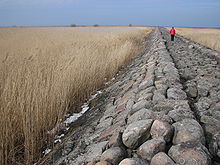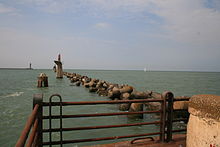- Mole (architecture)
-
 The North Pier at Ainaži, Latvia. The projection into the sea is in the far distance. This mole formerly supported a light railway.[1]
The North Pier at Ainaži, Latvia. The projection into the sea is in the far distance. This mole formerly supported a light railway.[1]
A mole is a massive structure, usually of stone, used as a pier, breakwater, or a causeway between places separated by water. The word comes from Middle French mole and ultimately Latin mōlēs meaning a large mass, especially of rock and has the same root as molecule.[2]
 Alameda Mole, San Francisco East Bay
Alameda Mole, San Francisco East Bay
Historically, the term "mole" was used in the San Francisco Bay Area in California to refer to the combined structure of a causeway and wooden pier or trestle extending out from the eastern shore and utilized by various railroads, such as the Key System, Southern Pacific Railroad (two), and Western Pacific Railroad. By extending the tracks the railroads could get beyond the shallow mud flats and reach the deeper waters of the Bay that could be navigated by ferries. None of the four Bay Area moles survives today, although the causeway portions of each were incorporated into the filling in of large tracts of marshland for harbor and industrial development.
The two concrete moles protecting the outer harbour at Dunkirk played a significant part in the British evacuation of Dunkirk during World War II in May 1940. The harbour had been made unusable by German bombing and it was clear that troops were not going to be taken directly off the beaches fast enough. Naval captain W. G. Tennant had been placed ashore to take charge of the navy shore parties and organise the evacuation. Tennant had what proved to be the highly successful idea of using the East Mole to take off troops. The moles had never been designed to dock ships, but despite this, the majority of troops rescued from Dunkirk were taken off in this way.[3]
See also
References
- ^ "Vidzeme coastline", Official Latvian Tourist Portal, retrieved 9 January 2011.
- ^ John Simpson (ed), "mole, n.2", Oxford English Dictionary Online, retrieved 8 January 2011.
- ^ "Operation Dynamo, the evacuation from Dunkirk, 27 May-4 June 1940", Military History Encyclopedia on the Web, retrieved 8 January 2011.
Categories:- Construction terminology
- Architecture stubs
Wikimedia Foundation. 2010.

